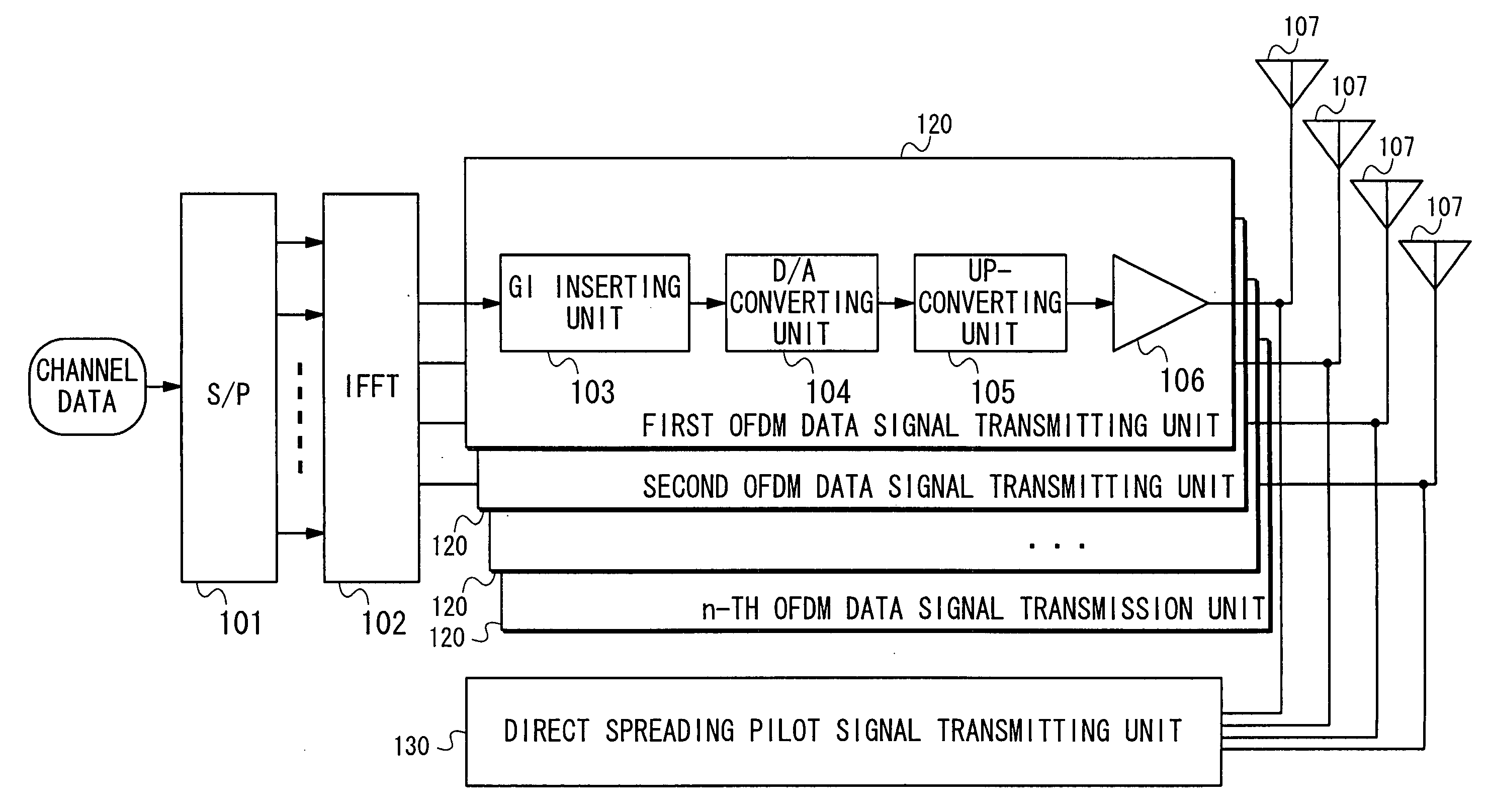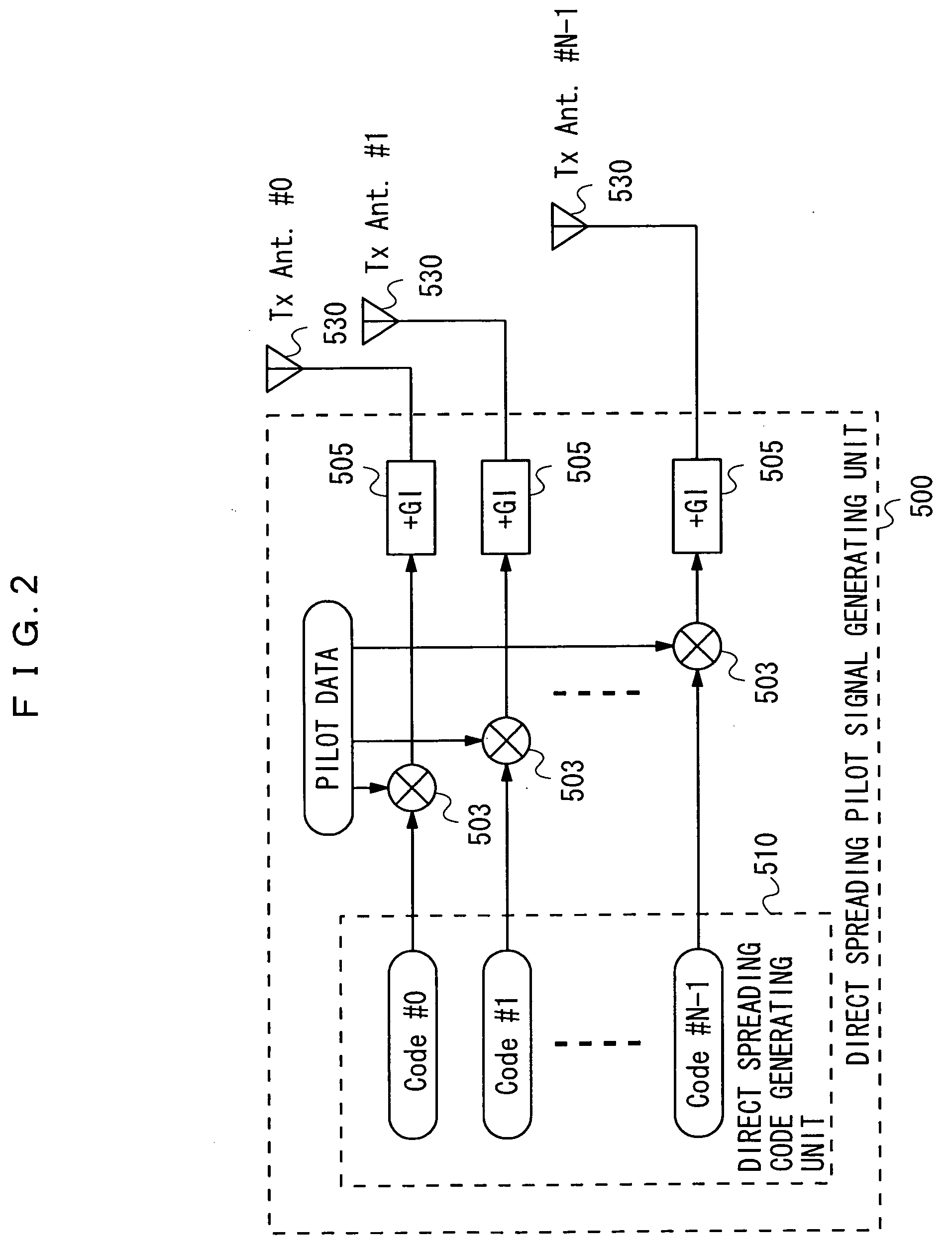MIMO-OFDM transmitter
- Summary
- Abstract
- Description
- Claims
- Application Information
AI Technical Summary
Benefits of technology
Problems solved by technology
Method used
Image
Examples
first embodiment
Operation and Effect in First Embodiment
[0069]According to the first embodiment discussed so far, in the direct spreading pilot signal generating unit 500, the direct spreading code generating unit 510 generates the direct spreading code per transmitting antenna. The direct spreading pilot signals generated from the direct spreading codes are transmitted simultaneously from the respective transmitting antennas.
[0070]In the direct spreading pilot signal receiving unit 600, the matched filters 603 wait for the signals with the direct spreading codes generated per transmitting antenna by the direct spreading code generating unit 510. When the reception signals are inputted to the matched filters 603, the delay profiles for calculating the channel estimation values are obtained from the pilot signals.
[0071]according to the first embodiment, the pilot signals for every transmitting antenna can be organized in a state causing no interference between the pilot signals by spreading the pilo...
second embodiment
Operation and Effect in Second Embodiment
[0087]According to the second embodiment discussed so far, in the direct spreading pilot signal generating unit 700, the direct spreading code generating unit 710 generates the direct spreading code. Generated also is the direct spreading pilot signal given the phase shift of which quantity is different for every transmitting antenna. This direct spreading pilot signal is transmitted from each transmitting antenna.
[0088]In the direct spreading pilot signal receiving unit 800, the matched filter 803 waits for the signals with the direct spreading code generated by the direct spreading code generating unit 710. When the reception signals are inputted to the matched filter 803, the delay profiles of all of the transmitting antennas are obtained.
[0089]According to the second embodiment, the transmitting time of the pilot signals can be reduced. Further, only one matched filter may be sufficient by utilizing the same direct spreading code for all ...
third embodiment
Operation and Effect in Third Embodiment
[0103]According to the embodiment discussed so far, in the direct spreading pilot signal generating unit 900, the direct spreading code generating unit 910 generates the direct spreading code (M-sequence code). Generated also is the direct spreading pilot signal that is phase-shifted with a quantity different for every transmitting antenna. The direct spreading pilot signals are transmitted simultaneously from the respective transmitting antennas.
[0104]In the direct spreading pilot signal receiving unit 1000, the matched filter 1003 waits for the signals with the direct spreading code (M-sequence code) generated by the direct spreading code generating unit 910. When the reception signals are inputted to the matched filter 1003, the delay profiles of all of the transmitting antennas are obtained.
[0105]According to the third embodiment, the transmitting time of the pilot signals can be reduced. Moreover, all of the transmitting antennas use the ...
PUM
 Login to View More
Login to View More Abstract
Description
Claims
Application Information
 Login to View More
Login to View More - R&D
- Intellectual Property
- Life Sciences
- Materials
- Tech Scout
- Unparalleled Data Quality
- Higher Quality Content
- 60% Fewer Hallucinations
Browse by: Latest US Patents, China's latest patents, Technical Efficacy Thesaurus, Application Domain, Technology Topic, Popular Technical Reports.
© 2025 PatSnap. All rights reserved.Legal|Privacy policy|Modern Slavery Act Transparency Statement|Sitemap|About US| Contact US: help@patsnap.com



